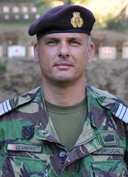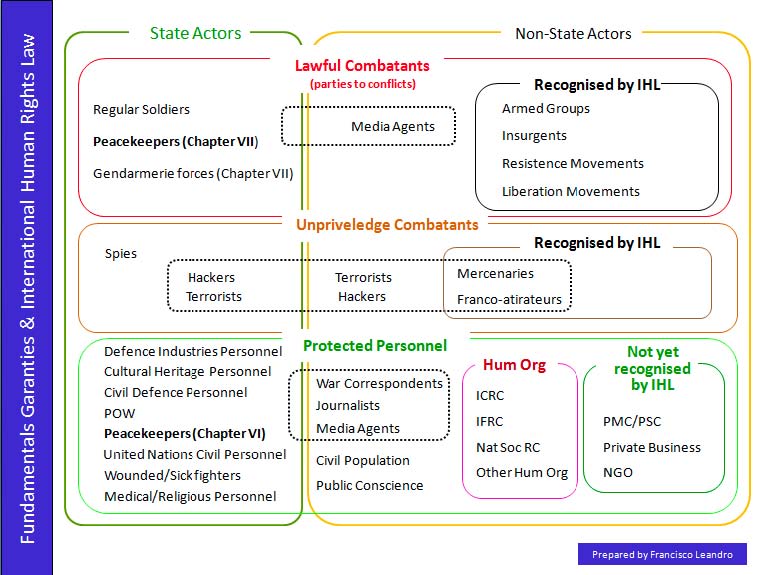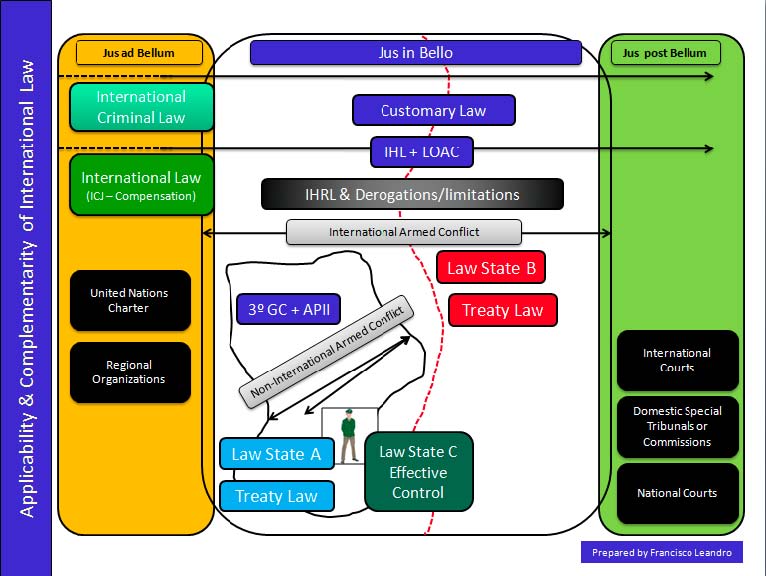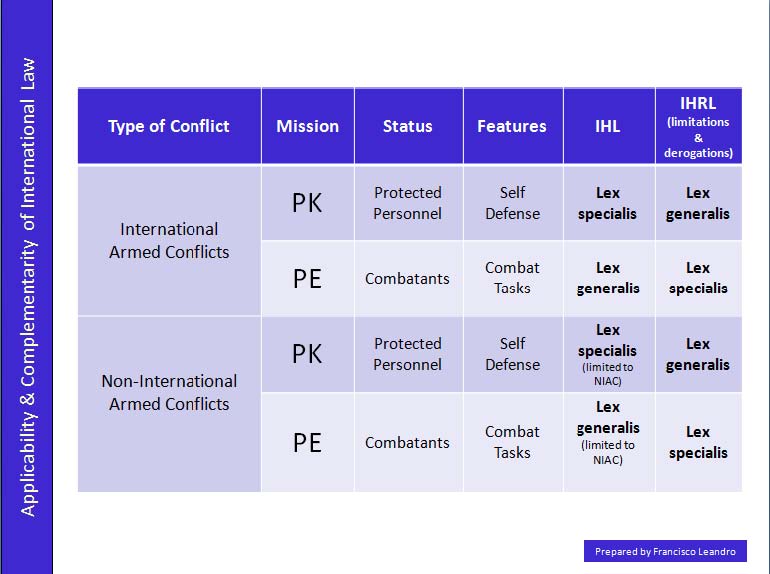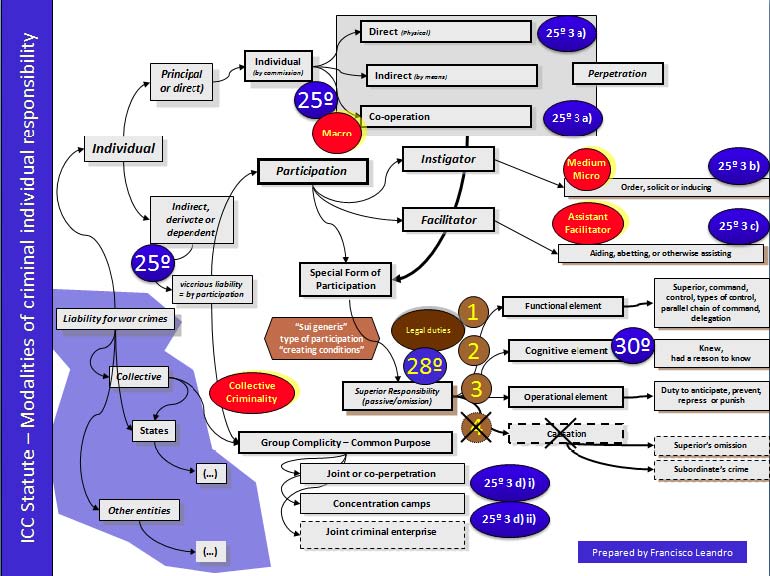Identifying and discussing the problems regarding the application of International Humanitarian Law in Peace Operations
“It was the end of the first day of a hundred-day civil war and a genocide that would engulf all of us in unimaginable carnage… we were still faced with the restrictions on our ROE… which made these rescue efforts a matter of luck and persuasion rather than of force.”
Lt Gen Roméo Dallaire1
1. Background & Outline
“Beati gli operatori di pace,
perché saranno chiamati figli di Dio.
Vangelo secondo Matteo 5, 1-12a
In line with the United Nations2 and NATO definition of peacekeeping3 we generically understand it as the use of military forces, provided by contributing States, to intervene in another State or States territory on behalf of the United Nations, with4 or without5 the consent of the host State, and based on the United Nations «mandate». In the light of these definitions we understand peacekeeping personnel, departing from the provisions of the Convention on the Safety of United Nations and Associated Personnel6, “as individuals engaged or deployed by the Secretary-General of the United Nations as members of the military, police or civilian components of a United Nations operation, or other officials and experts”. Therefore, the aim of the present essay is to identify and discuss the application of the International Humanitarian Law (Geneva Law and Hague Law), hereinafter referred to as IHL and the International Human Rights Law, hereinafter referred to as IHRL to peacekeeping operations, as foreseen by the Capstone Doctrine7.
Consequently, the essay outline is organized in three different areas: firstly and foremost the questions related to the peacekeeping forces legal status, secondly the issues concerning the applicability and complementarities of international law in peace operations and thirdly, the problems arising from the peacekeepers individual accountability as an international law enforcement mechanism. Lastly, conclusions will be drawn attempting to summarize essential ideas.
2. “Jus ad bellum”: Peacekeeping Forces Legal Status
“It is clearly a fact that the use of force and the legal status
of personnel in peace operations are connected.”
Ola Engdahl8
The status of peacekeeping forces members is, indeed, a key legal issue, which impacts extensively on the application of IHL and IHRL when forces are deployed. The diagram 1 organizes the participants in an armed conflict9 mainly in four categories:
- State actors;
- Non-State actors;
- Lawful combatants;
- Protected personnel.
Diagram 1
For the benefit of the present analysis and regardless all different generations of PK operations, we consider the employment of PK forces, by the United Nations in a theatre of operations, is based either on the consent of the warring parties (PK) or based on the threat to international peace (PE)10. Consequently, on one hand and taking into account the nature of the international mandate, the existence of a SOFA/SOMA11 and bearing in mind the article 43º PA I to the GC12 the legal status of PK forces members might be defined as follows:
- State actors mandated by United Nations13;
- Protected personnel holding special duties (they are not part to the armed conflict14).
On the other hand, the legal status of PE forces might be defined as follows:
- State actors mandated by United Nations;
- Lawful combatants (they do not have the consent of the warring parties, they carry out an enforcement of the tasks assigned by the UN mandate and are organized according to article 43º PA I to GC).
The United Nations, Secretary-General’s Bulletin, ST/SGB/1999/13 - dated of 6th August 1999, further clarifies the issue by stating that:
“1.1 The fundamental principles and rules of IHL... a applicable to Uni ted Nations forces when... they are actively engaged therein as combatants... They are accordingly applicable in enforcement actions or in peacekeeping operations when the use of force is permitted in self-defence.
1.2 The promulgation of this bulletin does not affect the protected status of members of peacekeeping operations under the Convention on the Safety of United Nations and Associated Personnel or their status as non-combatants, as long as they are entitled to the protection given to civilians under the international law of armed conflict”.
3. “Jus in bello”: Applicability & Complementarities of the International Humanitarian Law
“War will remain cruel…
will never be adequate compliance…
aimed at curbing that cruelty.”
Yves Sandoz15
Taking into consideration the diagrams 2 and 3 the problem of law applicability to PK forces during an operational deployment, might be structured in three different areas of concern:
Diagram 2
Diagram 3
a) It is widely accepted that general customary law binds States that have no persistently and openly dissent in relation to a rule16. In addition, States are greatly encouraged to adopt national laws incorporating these rules into their domestic legislation to ensure adequate national compliance. Therefore, regardless the international treaty law «acquis» binding the sending State, general customary law applies in principle to PK forces members belonging to that State17;
b) The applicability18 of IHL and IHRL by PK forces members, recalls simultaneously the type of armed conflict, and the ultimate scope of preservation of values. On one hand, IHL regulates between field armed adversaries, directed towards the protection of individuals and limitation of human suffering. On the other, IHRL rules within a State, and regulates the relationship between that State and the individuals under its jurisdiction, attempting to prevent abuse of power by the State;
Consequently, in international conflicts, IHRL is binding upon military PK19 personnel, as lex generalis, according to the extraterritorial jurisdiction regime, in their relation with individuals taking no active part in the hostilities and in their effective control. Likewise, IHL is also binding upon military PK personnel, as lex specialis, in line with their State treaty law20 and in their relation with the opposing forces, every time that armed force is used in self-defense. Besides, in these type of conflicts, IHL binds PE personnel as lex generalis and in their “armed relation” with the opposing forces (combat actions), and IHRL is binding as lex specialis in their relation with individuals taking no active part in the hostilities and in their effective control. Furthermore, in non-international armed conflicts, the applicable provisions of the sending State treaty law IHL21 applies to PE forces as lex generalis and IHRL22 provisions in force within the jurisdiction of the sending State are also binding as lex specialis23, every time they act as public authority and not as combatants. Likewise, IHL binds PK forces as lex specialis and IHRL as lex generalis24;
c) Non-treaty standards - Besides the problems associated with treaty application, other instruments must be taken into account. In fact, regardless the status of peace forces members and the type of conflict they are involved, these individuals have to comply with bilateral and multilateral agreements such as the SOFA, with the profile of ROE25, which are functioning as lex specialis26 under the scope of IHL/IHRL application. Moreover, in certain exceptional cases local law might also apply. Finally, the UNSC Resolutions override IHL/IHRL provisions, except in issues of jus cogens.
4. “Jus post bellum”: The Remedies of Individual Accountability
“The doctrine of superior responsibility is
an extraordinary legal and prosecutorial instrument.”
Guéanael Mettraux27
With the diagrams 4 and 5 in mind, this paragraph addresses the judicial remedies for the violation of IHL/IHRL by PK forces members. Different types of responsibility are at stake: concurrent State responsibility, United Nations responsibility and individual criminal responsibility. Both States and peacekeepers are accountable but in different perspectives. States are accountable before other States (in case of violation of international treaty law by a State official or for their own behavior) and the aim is, in principle, to obtain compensation or reparation. Besides, we should bear in mind State responsibility doesn’t preclude individual responsibility and vice-versa. Thus, peacekeepers are criminally accountable for their acts as combatants and for their individual actions as State agents (in their official relation with other individuals under their State jurisdiction). In this case the aim is to obtain individual punishment as deterrent to prevent future violations. Individual accountability plays a key role in terms of applicability of international law by peacekeepers.
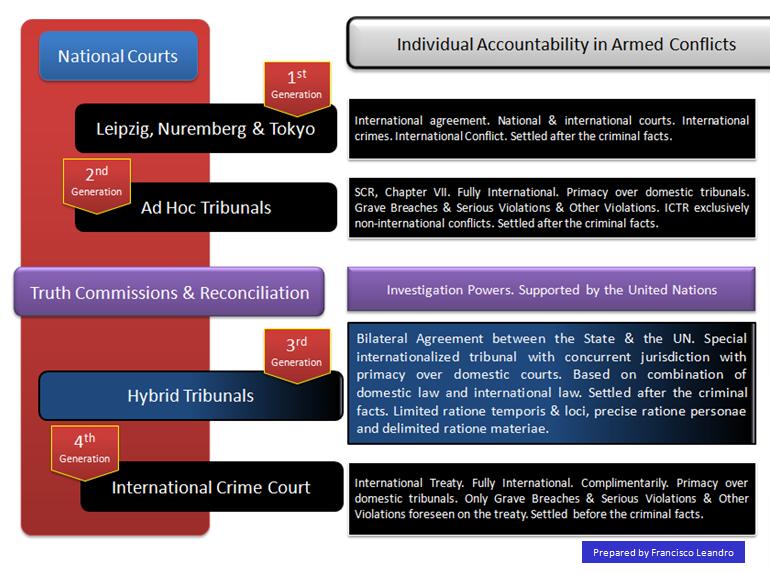
Diagram 4
Diagram 5
However, the standard SOFA provides that peacekeepers are subject to exclusive jurisdiction of their contributing State in respect of any criminal offenses, which may be committed by them in the host nation territory28. In return for an absolute immunity from local jurisdiction, the State of nationality is expected to prosecute offenders before national courts28. In return for an absolute immunity from local jurisdiction, the State of nationality is expected to prosecute offenders before national courts29, based on their extraterritorial responsibility to prosecute. The latest decisions of the European Court of Human Rights have significant consequences on the protection of human rights in peace operations, especially the argument of the «effective control» in Behrami & Saramati case law30. The glimmer of hope however, was given by the same tribunal on Al-Saadoon and Mufdhi v. The United Kingdom31 by accepting the jurisdiction over British troops deployed in Iraq on an IHRL related case law. That is why national courts and as last resort the 3rd/4th generation tribunals32 are essential to bring justice to the victims and deterrence to impunity.
Nevertheless, it is the modern criminal law doctrine of superior responsibility that provides a remarkable opportunity to held accountable individuals who are acting as States agents. The adherence to these legal instruments and its incorporation into State domestic legislation is paving the way to defeat criminal impunity. In this context, the doctrine of command responsibility33 applicable by the law of the sending State, together with the United Nations mechanisms of inquiry and denounce, are the right leverage to prevent or at least deter individual breaches of international law.
5. Conclusions
“Individuals have international duties,
which transcend the national obligations…”
International Military Tribunal at Nuremberg
quoted by ICTY in Furundžija34
States commit military forces to United Nations35 to protect the basic rights of the weak, defenseless, elderly, children, women, lame, innocent, and all victims in general, from brutal living conditions and inhumane acts of unspeakable violence, behind of an orgy of insane madness that harm the most humble human existence. Thus, it seems quite obvious that the only way the defend rights is to abide by the law that protects precisely the same rights.
However, in spite of the lack of clarity traced by European Court of Human Rights on the recent cases involving peacekeeping forces, and the absence of case law before other international courts directly involving peacekeepers, the IHL and IHRL are binding PE forces acting as State actors engaged as combatants and when the PK forces are acting as protected personnel, both in international and non-international armed conflicts. Additionally, general customary law binds at anytime and national State law travels with peacekeeping forces everywhere. The glimmer of hope that paves modern legal challenges to contemporary peacekeeping lies with responsible States together with deeper clarification of the United Nations accountability departing from the duties mentioned on UNSG bulletin. For the time being, sending States must surveying from the Armageddon36 of their domestic law, in close coordination with the United Nations inquiry mechanisms. States should also empower their willingness to adopt international standards and to prosecute accordingly their individuals, who instead of defending essential values, failed to act according to the international well accepted rules.
* Tenente-coronel de Artilharia. Doutorado em Ciência Política e Defesa pela Universidade Católica. Advanced Diploma in International Humanitarian Law and Peace Operations, Istituto per gli Studi di Politica Internazionale (ISPI) - Milan/Italy & Institute of International Humanitarian Law (IIHL) - Sanremo/Italy. Desempenha actualmente funções de Chief Public Affairs na EUROFOR.
1 United Nations Assistance Mission in Rwanda (UNAMIR) Force Commander - Shaking Hands with the Devil, Arrow Books (2004), ISBN 978-0-679-31171-3 , pages 262-264.
2 For the purpose of the present document peacekeeping is a generic expression which expresses the possibility of using the military force, by the international community, based on the host State consent and should be understood as “… a technique to preserve the peace, however fragile, where fighting has been halted, and assist in implementing agreements achieved by the peacemakers” (United Nations Peacekeepers Guidelines, 2008, p. 18) and encompasses traditional, multifunctional and robust peacekeeping.
3 NATO Allied Joint Publication 3.4 (A) p. 3-3 - §304 (2005). Peace Support Operations - Peacekeeping operations are generally undertaken in accordance with the principles of Chapter VI of the UN Charter to monitor and facilitate the implementation of a peace agreement. A loss of consent and a non-compliant party may limit the freedom of action of the Peacekeeping force and even threaten the continuation of the mission. Thus the requirement to remain impartial, limit the use of force to self-defence, and maintain and promote consent, should guide the conduct of Peacekeeping - (1) Peace Enforcement operations normally take place under the principles of Chapter VII of the UN Charter. They are coercive in nature and are conducted when the consent of all Parties to the conflict has not been achieved or might be uncertain. They are designed to maintain or re-establish peace or enforce the terms specified in the mandate. (2) The goal of Peace Enforcement missions is to enforce the provisions of a mandate designed to maintain or restore peace and order to allow the operations of a separately mandated Peacekeeping force.
4 (PK) Peacekeeping - Peacekeeping forces under United Nations Chapter VI Pacific Settlement of Disputes - based on host State consent.
5 (PE) Peace Enforcement - Peace enforcement forces under United Nations Chapter VII based on the threat to international peace. Chapter VII - Action with respect to threats to the peace, breaches of the peace, and acts of aggression.
6 Article 1º (a) and (b) - (A/RES/49/59, 9th of December 1994) considering also the Optional Protocol to the Convention on the Safety of United Nations and Associated Personnel (2005) - This Protocol has not yet entered into force (February 2011).
7 United Nations Peacekeeping Operations Principles and Guidelines (2008), p. 14 - IHRL is an integral part of the normative framework for United Nations peacekeeping operations. The Universal Declaration of Human Rights, which sets the cornerstone of international human rights standards, emphasizes that human rights and fundamental freedoms are universal and guaranteed to everybody. United Nations peacekeeping operations should be conducted in full respect of human rights and should seek to advance human rights through the implementation of their mandates... (p. 15) United Nations peacekeepers must have a clear understanding of the principles and rules of international humanitarian law and observe them in situations where they apply.
8 The legal status of United Nations and associated personnel in peace operations and legal regime protecting them - 31st Round Table on Current Problems of IHL, Sanremo 4-6th September (2008), IIHL (January 2009), p. 117.
9 For the benefit of the present essay we understand armed conflict as follows: “… an armed conflict exists whenever there his a resort to armed force between States or protracted armed violence between governmental authorities and organised armed groups or between such groups within a State.” International Criminal Tribunal for the Former Yugoslavia - Case nº. IT-94-1-A72, Prosecutor v. Duško Tadić a/k/a “Dule”, Appeals Chamber, 2nd October 1995, §70 (1994-1995), 1 ICTY JR 352, at §70, reprinted in International Legal Materials, vol. 35 (1996), p. 32 and ICTY Prosecutor vs Kovac, Appeals Chamber, (12th of June 2002), §50. Besides, we also consider the Report of the International Law Commission (A/63/439) on the work of its Sixth Committee “Effects of armed conflicts on treaties”: “Armed conflict means a state of war or a conflict which involve armed operations which by their nature or extent are likely to affect the operation of treaties between States parties to the armed conflict or between States parties to the armed conflict and third States, regardless of a formal declaration of war or other declaration by any or all of the parties to the armed conflict ( A/RES/63/123 , 11th of December 2008)”. This definition is based on the proposal adopted by the Institute of Internacional Law (28th of August 1985).
10 PE - Peace enforcement forces under United Nations Charter - Chapter VII - Action with respect to threats to the peace, breaches of the peace, and acts of aggression.
11 Status of Forces (Mission) Agreement is an international agreement between a host country and a foreign nation or international organization stationing forces in that country. This agreement that defines the legal position of a visiting military force deployed in the territory of another State - Rules of Engagement Handbook, International Institute of Humanitarian Law, (2009), Annex D. The practice of United Nations, NATO, African Union and European Union is to render immune from local jurisdiction the members of peacekeeping forces launched under UN Chapter VI.
12 Additional Protocol of 1977 of Geneva Convention of 1949 - Section II - Combatants and Prisoners of War Status - Article 43º - Armed forces: 1. The armed forces of a party to a conflict consist of all organized armed forces, groups and units which are under a command responsible to that Party for the conduct of its subordinates, even if that Party is represented by a government or an authority not recognized by an adverse Party. Such armed forces shall be subject to an internal disciplinary system which, inter alia, shall enforce compliance with the rules of international law applicable in armed conflict. 2. Members of the armed forces of a Party to a conflict (other than medical personnel and chaplains covered by Article 33º of the Third Convention) are combatants, that is to say, they have the right to participate directly in hostilities. 3. Whenever a Party to a conflict incorporates a paramilitary or armed law enforcement agency into its armed forces it shall so notify the other Parties to the conflict. Article 44º - Combatants and prisoners of war: 1. Any combatant, as defined in Article 43º, who falls into the power of an adverse Party shall be a prisoner of war. Is also relevant to consider the article 2º, 2 of the Convention on the Safety of United Nations and Associated Personnel (A/RES/49/59, 9th December 1994) - This Convention shall not apply to a United Nations operation authorized by the Security Council as an enforcement action under Chapter VII of the Charter of the United Nations in which any of the personnel are engaged as combatants against organized armed forces and to which the law of international armed conflict applies. Also in the International Crime Court Statute there is a provision (article 2º, b), iii) which criminalizes intentionally directing attacks against personnel, installations, material, units or vehicles involved in a humanitarian assistance or peacekeeping mission in accordance with the Charter of the United Nations, as long as they are entitled to the protection given to civilians or civilian objects under the international law of armed conflict.
13 “…unable to setup the UN armed forces envisage in the articles 43º of the UN Charter, …, the UN as gradually confined itself to authorizing the use of force by member states.“ Antonio Cassese, International Law, Oxford Press, 2nd edition (2005), p. 346.
14 In the category of peacekeeping forces and considering either the so called classical tasks or the tasks of second generation, we foresee the use of armed force by the State limited to self-defence and in the context of the mission assigned by the United Nations Security Council or other regional body under its authorization.
15 Customary International Law, Jean-Marie Henckaerts & Louise Doswald-Beck, Volume I, ICRC 2009, p. xxi.
16 Abdul G. Koroma, Customary International Law, Jean-Marie Henckaerts & Louise Doswald-Beck, Vol I, ICRC 2009, p. xix.
17 There are many examples of customary rules. The following three examples are considered customary law, applicable in international conflicts and non-international conflicts: Rule 59 - The improper use of the distinctive emblems of the Geneva Conventions is prohibited; Rule 86 - The use of laser weapons that specifically designed, as their sole combat function or as one of their combat functions, to cause permanent blindness to unenhanced vision is prohibited; Rule 90 - Torture, cruel or inhuman treatment and outrages upon personal dignity, in particular humiliating and degrading treatment are prohibited. Customary International Law, Jean-Marie Henckaerts & Louise Doswald-Beck, Vol I, ICRC (2009), pages 207, 292 and 315.
18 And eventual complementarity between IHL and IHRL.
19 The legislative powers of the sending State might impose derogations and the limitations on IHRL. These derogations and limitations shall be considered accordingly. Article 15º of the European Convention on Human Rights foresees the establishment of the derogation measures in time of war and other public emergencies.
20 Here in this context we consider the volunteer treaty law. Thus, the application of this law, calls for an evaluation of the international treaties reserves made by the State.
21 IHL in non-international conflicts is mainly associated to Article 3º Common to the four Geneva Conventions, and i ’ Additional Protocol II.
22 Juan Carlos Abella v. Argentina, Case 11.137, Report nº 55/97, Inter-American CHR, OEA/Ser.L/V/II.95 Doc. 7 rev. at 271 (1997), §244 - “... The exercise of public authorit y has certain limits which derive from the fact that human rights are inherent attributes of human dignity and are, therefore, superior to the power of the State...” Nicaragua v. United States of America, International Court of Justice, June 27, (1986), §115 - United States directed or enforced the perpetration of the acts contrary to human rights and humanitarian law alleged by the applicant State; §255 - By virtue of such general principles, the United States is bound to refrain from encouragement of persons or groups engaged in the conflict in Nicaragua to commit violations of Article 3º, which is common to all four Geneva Conventions of 12th of August 1949.
23 ICJ, Advisory Opinion and Orders, legality of the threat or use of nuclear weapons - 8th of July (1996), p. 240, §25 - The Court observes that the protection of the International Covenant on Civil and Political Rights does not cease in times of war, except by operation of Article 4º of the Covenant, whereby certain provisions may be derogated from in a time of national emergency. Respect for the right to life is not, however, such a provision. In principle, the right not arbitrarily to be deprived of one’s life applies also in hostilities. The test of what is an arbitrary deprivation of life, however, then falls to be determined by the applicable lex specialis, namely, the law applicable in armed conflict which is designed to regulate the conduct of hostilities. Thus, whether a particular loss of life, through the use of a certain weapon in warfare, is to be considered an arbitrary deprivation of life contrary to Article 6º of the Covenant can only be decided by reference to the law applicable in armed conflict and not deduced from the terms of the Covenant itself.
24 The Isayeva v. Russia Case Law (2005) before the ECtHR shows the applicability of the IHRL to a situation where one of the parties (Russia) used armed force, against civilians not involved in armed actions, employing military means as it was facing an armed conflict. Similar is the situation of PK forces in non-international armed conflicts in their relation with civilians not involved in military operations, bearing in mind that their presence is based on the consent of the warring factions.
25 MC 362/1 - NATO Rules of Engagement (ROE) are the authorisation for, or limits on, the use of force during military operations - p. 2. Joint Publication 1-02, DoD Dictionary of Military and Associated Terms, 1994: ROE are directives issued by competent military authority which delineate the circumstances and limitations under which United States forces will initiate and/or continue combat engagement with other forces encountered. Rules of Engagement Handbook, IIHL (2009), p. 1, part 1 - ROE are issued by competent authorities and assist in the delineation of the circumstances and limitations within which military forces may be employed to achieve their objectives. ROE appear in a variety of forms in national military doctrines, including execute orders, deployment orders, operational plans, or standing directives. Whatever their form, they provide authorisation for and/or limits on, among other things, the use of force, the positioning and posturing of forces, and the employment of certain specific capabilities. In some nations, ROE have the status of guidance to military forces; in other nations, ROE are lawful commands.
26 Here are not included the non binding instruments such as codes of conduct, internal guidance or other type of internal documents.
27 The Law of Command Responsibility, Oxford University Press, (2009), p. 272.
28 Or using other words Host State immunity from jurisdiction.
29 Daphana Shraga, The applicability of international humanitarian law to peace operations, from the rejection to acceptance, International Humanitarian Law, Human Rights and Peace Operations - 31st Round Table on Current Problems of IHL, Sanremo 4-6th September (2008), IIHL (January 2009), p. 87.
30 The European Court of Human Rights (ECtHR) has recently established few interesting case law in order to understand when can a State be held accountable for HR violations committed by members of its armed forces deployed as international peacekeepers? In the case Banković and Others v Belgium and Others and Markovic and Others v Italy, the ECtHR addressed complaints relating to NATO’s use of armed force against the Federal Republic of Yugoslavia (FRY) in 1999. The cases Behrami and Behrami v France and Ruzhdi Saramati v France, Germany and Norway arose out of events relating to the international territorial administration of Kosovo. On the Banko ić case the ECtHR held that it was incompetent ratione personae to review the conduct of these international presences and therefore declared the case inadmissible. On the Behrami and Saramati the Court concluded that the alleged human rights violations were attributable to the United Nations (effective control criteria) and not to the individual troops contributing nations (TCN), and therefore the Court was not competent ratione personae to examine the relevant actions.
31 Al-Saadoon and Mufdhi v. United Kingdom (nº. 61498/2008) judgment by a Chamber of the European Court of Human Rights where the questions was related to the transfer by the UK of the applicants who were in the custody of UK troops in Iraq to Iraqi authorities for trial violated the applicants ECHR rights, specifically the non-refoulement principle established by the Court in Soering v. United Kingdom, inter alia because there was serious risk of them being subjected to the death penalty. Trial §165 - In conclusion, the Court does not consider that the authorities of the Contracting State took all steps which could reasonably have been taken in order to comply with the interim measure taken by the Court. The failure to comply with the interim measure and the transfer of the applicants out of the United Kingdom’s jurisdiction exposed them to a serious risk of grave and irreparable harm. §171 - In the present case, the Court has found that through the actions and inaction of the United Kingdom authorities the applicants have been subjected to mental suffering caused by the fear of execution amounting to inhuman treatment within the meaning of Article 3º. While the outcome of the proceedings before the IHT remains uncertain, that suffering continues. For the Court, compliance with their obligations under article 3º of the Convention requires the Government to seek to put an end to applicants’ suffering as soon as possible, by taking all possible steps to obtain an assurance from the Iraqi authorities that they will not be subjected to the death penalty.
32 The issue of prosecution of peacekeepers before international jurisdictions started in 2002 by the United States, expressing concerns regarding the jurisdiction of the ICC. On 12th of July 2002 the UNSC passed the Resolution 1422 under Chapter VII of the UN Charter and referring to the article 16º of the Rome Statute, not to commence or proceed with the investigation or prosecution of any current or former member of UN Operation. This deferral was valid for 1 year, and was extended by the Resolution n.º 1487 of 12th of July 2003. Daphana Shraga, The applicability of international humanitarian law to peace operations, from the rejection to acceptance, International Humanitarian Law, Human Rights and Peace Operations - 31st Round table on Current Problems of IHL, Sanremo 4-6th September (2008), IIHL (January 2009), p. 88.
33 Besides the individual criminal responsibility, each military commander is entrusted with a responsibility to control his forces and to prevent, repress and punish criminal acts.
34 IMT - Vol. 1, p. 223 - Furundžija (IT-95-17/1) 10th December 1998, ‘’Lašva Valley’’ Trial, §155.
35 Or to other regional organizations to act on behalf of the United Nations.
The Mount Armageddon is the site of an epic battle associated with the end time prophecies of the Abrahamic religions. The word Armageddon appears only once in the Greek New Testament and comes from Hebrew meaning “Mountain of Megiddo”. Megiddo was the location of many decisive battles in ancient times. Thus, the word Armageddon is use to express de idea of a place where decisive battles were fought. The compliance with international law by peace forces is, indeed, an extremely important battle to conquer action legitimacy.

